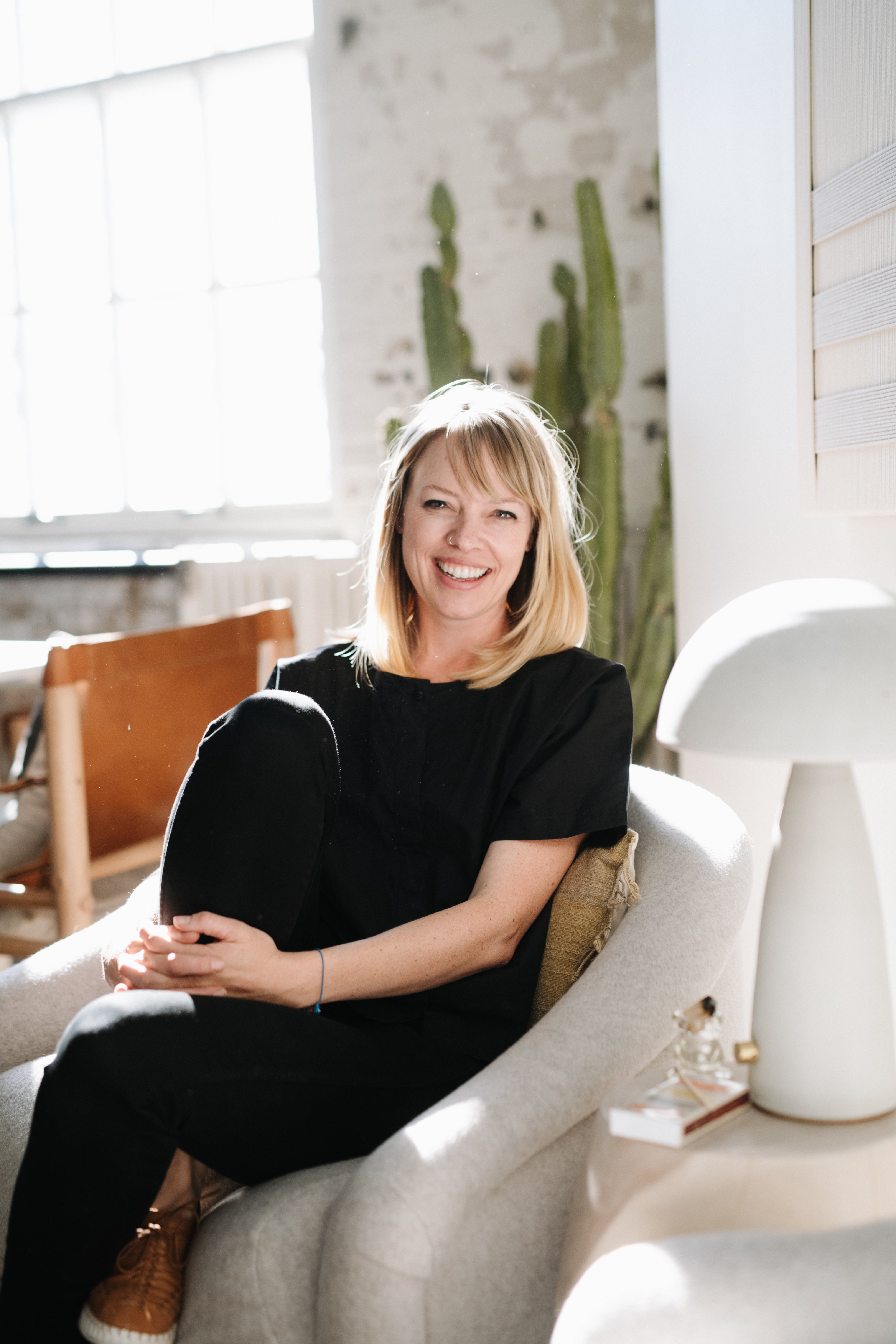The 50 States Project is a series of candid conversations with interior designers across the country about how they’ve built their businesses. This week, Minneapolis-based designer Julia Miller of Yond Interiors tells us tells us why she’s using local vendors on cross-country projects, how her search for the perfect office space will help her team level up, and why she’s reevaluating her approach to billing her clients in order to focus on value rather than deliverables.
I’ve been following your search for a new office space on Instagram. What are you looking for?
When we did our end-of-year goal planning as a team last year, we all agreed that a new office was paramount. Our current office, which we’ve been in since 2020, is a very small 600-square-foot room, and the building is very old. There are a lot of mice and weird bugs; it’s cold in the winter and hot in the summer. It’s been good enough while we get started, but it’s not client-facing at all, nor the creative launchpad we all hope for.
We’ve had two spaces we were interested in, and both now might fall through. So it’s harder to be there now because we’ve all geared ourselves up to be done. The thought of having to stick out another hot summer in there—we’re like, “What the heck?” But it’s hard to find a good space. We don’t necessarily want something that’s super retail-y, but something on ground level would be great. So we’ll see. I believe that things that are meant for us come to us, and if these spaces weren’t meant for us, then they just won’t stick, but it is a disappointing process.
What’s your vision for the future client-facing space?
As we get bigger projects, a lot of collaboration—not only with the client but with the architect and the builder. There are a lot of meetings. And now that people are like, “Let’s just meet in person” or “Come to my office,” I find it’s much easier to do that kind of stuff and get a lot more of the relational juju. But we can’t host any of those types of meetings. I don’t even have a nice spot to take a Zoom call. Right now I’m on a walk because our office is so small that if one person has a meeting or a call, everybody’s on the call with you, you know?
I’m guessing your business looked a lot different when you got this office.
When I signed the lease, it was just me and a project manager/designer—she did both roles. I was kind of naive about any sort of future planning at that point in my career—when I signed, I thought, “This is going to be the perfect spot for us forever.” It caught me by surprise that the business has grown and evolved because I had no idea that that could happen.
I spent 15 years in clinical social work before this, so this is my big midlife career change. I was not a business person. I’ve grown into being a business person, but I didn’t have any sense of strategic planning or goal setting when I started. And this office was perfect for us at that time, and the price point is amazing. So in that way, it was a very smart decision. Now we are a full-time team of four, including myself, and we just hired a part-time contractor for design in addition to our part-time contracted bookkeeper. One of our team members lives in Michigan and is fully remote, but there are still three to four of us in the office every day now.
When did you realize design could be a career for you?
Like most designers, I’ve felt like it was part of my life forever. I’ve always been inclined to it—fussing with my own house, secretly keeping a pulse on everything happening in the interior design world. But as a social worker, I felt a little bit like, “How can I make moral sense of a career change?” Social work felt like a vocation and a calling. I also didn’t have the confidence—[partly] because I didn’t have any design education. The only experience I had when I started seriously thinking about it was my own house. I just thought, “Well, it’s not possible.”
What changed your thinking?
After I finished my own home project, which wrapped up in 2019, it was published in Better Homes & Gardens and in local publications. It felt like the opportunity to do it—I had good momentum, and it gave me that external validation I needed to be like, “You can do this if you want to.” I turned 35 that year, and I was like, “OK, I could be a career social worker”—I had a federal job; I was very set. With my clinical license, I’d reached the top of my field in terms of my education. I could have stayed there forever, but I was secretly thinking, “But what if I don’t try this? How disappointed will I be?” I had this epiphany: “If I die alone in a room by myself, will I feel sad that I didn’t live out this part of my yearning?” And the answer was yes. It was very much a personal pursuit, which is why I think I chose a small office. I was thinking small because I was thinking, “This is for me to decide if I like this.”
I started getting small Instagram inquiries from people all over the country—like, “Would you help me with lighting for my house?” And I was like, “OK, I’m just going to say yes to everything.” I did one-room paint sampling. I did hardware for a house. I did lighting. And it grew and grew and grew into bigger projects. I was also still at my clinical job, so this was in addition to that work. I did both for about a year and a half, and then I officially quit [social work] in February 2020, right before we knew it was going to be a pandemic. I freaked out for a bit, and then all of a sudden, like most designers, I was overwhelmed and we got jet-fueled forward. Market conditions cannot be overlooked in how we got to where we are.
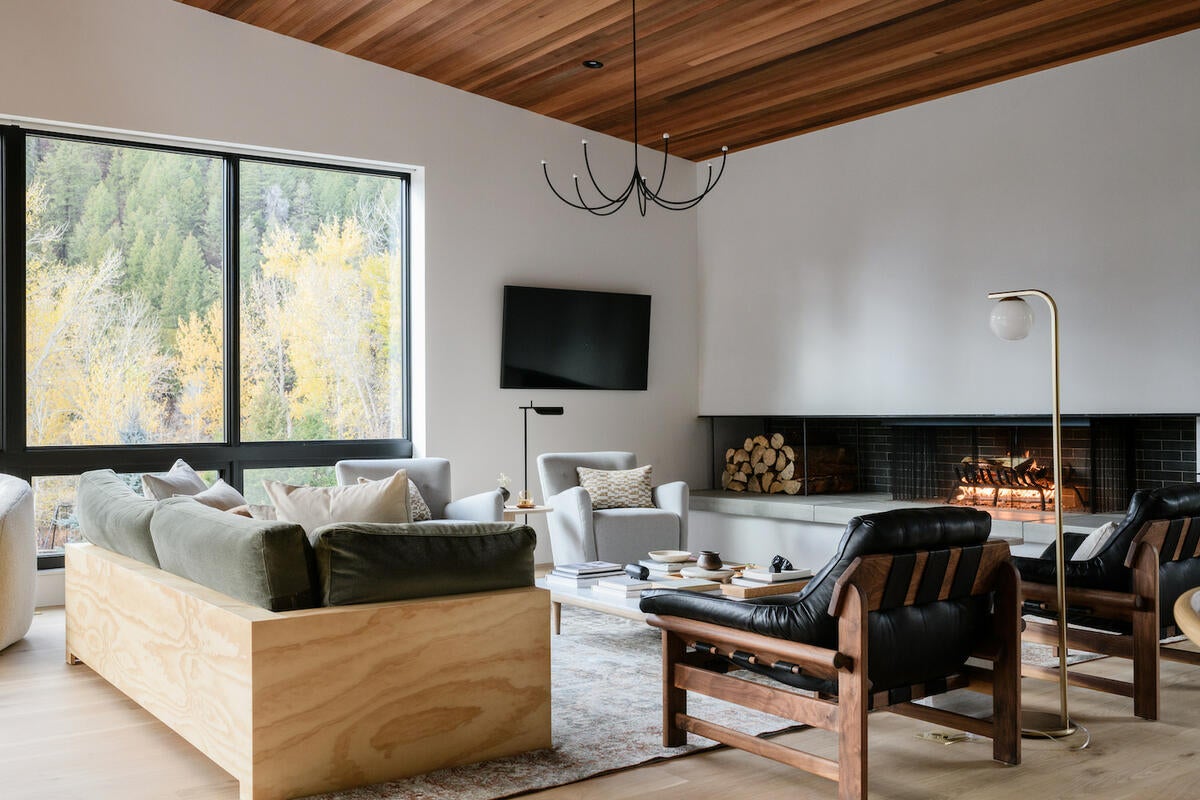
Going back for a second, were you looking to get your house published? Did you know that was going to help you launch the business?
I didn’t know about publishing, to be honest—it never occurred to me that could happen. And I didn’t think I was good enough. I had started an Instagram account while we were doing our project because my family lives out of state. Initially it was just to show friends and family what we were doing, but then people just started following. As that Instagram account grew, and as our project was coming together and I saw that people were really interested in it, I do think I had a strategic shift in how I started positioning myself. When I was selecting all of our finishes, I remember thinking, “Look, if this is ever going to be a business for me, I want to put my best foot forward.” So I selected things that I would do normally but also that reflected what I was interested in. Then the editor of Mpls.St.Paul magazine, Kelly Kegans, reached out to me because she had seen my account. It was a complete surprise that they were even interested. I think that’s what gave me the confidence to be like, “OK, Julia, you can do this if you want to, but you’ve got to do it now.”
What did getting published change for you?
It made me realize that people had been noticing me. Up to that point, I didn’t think it was meaningful. I thought it was the same level of engagement I gave to other accounts—like, “Oh, that’s cool. Can you tell me how you did that?” or “What’s that paint color?” I hadn’t thought it could lead anywhere.
The other thing is that I really struggled to feel like I was going to be good at this. I have a master’s degree, a clinical license—I’ve gone through a lot of training, and I came from a profession where there are a lot of very clear parameters and ethics around the work. I was used to abiding by specific rules of engagement. And because I was in a medical setting, I was used to documenting—everything had a purpose, and it was already set. I took that feeling and thought, “There’s a set way to do this [design] job, and I have no idea [what it is].” I think getting published answered for me that I could do the aesthetic part, and that if I put the time into figuring out the business part and the process part, I really could do this.
That’s why I was moonlighting at first: I didn’t want to quit a job that I truly felt called to and loved. But also, I needed to figure some stuff out. Before I quit my clinical work, I was like, “I’ve got to at least have a lawyer, a CPA and a process for clients to buy into.”
To focus on process that early is so rare.
That came from years of more rigid work where there was a process for everything and practice was how you knew you were successful. I’m a very process-minded person in general: I like to know how things should go. And so I listened to a million podcasts and read a bunch of books and talked to everybody I could about the business side of stuff.


What does a full plate look like today?
A full plate right now is 17 projects, all in various stages. Client work remains the heartbeat of our work, but we also design custom furniture, so a full plate includes thinking about how we want to expand some of our furniture offerings. We’re working on a custom cabinetry line right now. And then we’re also launching a vacation rental, Yond Cottage, this summer. For me, a full plate is having my hand in a lot of different things. Especially now, [when] a lot of designers are seeing a slowdown, how can we create a healthy and thriving business that isn’t entirely dependent on clients?
Beyond design work, a full plate looks like doing media and PR stuff like this; being engaged in what’s happening in the [larger] design world; and doing some light business consulting—helping other designers get started, answering questions, that kind of stuff. I’ve got a couple of those relationships that I really love, because I feel like the design community can be a little bit difficult to access and understand.
The heart of how I made the decision to transition out of social work was this idea that the work that I do now can be just as meaningful, but it has to be extremely intentional. So we’ve lately started to use the hashtag #feelingofhome because that encompasses what our whole goal is. The feeling of home can be in many different things—it can be our work for a client, or a custom piece that we’ve designed that they’ve purchased through a retailer. For us the intention is to create pieces that people get a feeling from or an experience, which is why Yond Cottage is really important to me. It’s been a fun, freeing project creatively, but I [also want to help provide] access to interesting, comforting design—a spot where people feel rested and rejuvenated but also delighted. It takes a lot of different things to make the financial wheels turn but also to keep people [including clients, staff and me] interested and engaged. I’m kind of always a dabbler.
We’re working on two single-family houses in Sun Valley with some developers. We don’t like the word “spec,” but they’re one-off houses that are going to be sold without a specific buyer in mind. So we’re trying that out. I don’t really say no to anything, which sometimes creates a lot of stress because we’re very busy. But I also feel like you don’t know until you try. So I’m trying to get better at determining what’s the best fit for all of [my team], not just what I might be interested in at the moment.
How are you reevaluating what makes for a good fit client- and project-wise?
This has been hard. We’re not maybe the best aesthetic fit for everybody, or the best budget fit for everybody. It took me time to realize that that’s not a bad thing—that saying no to someone, in some ways, might be a favor to them. I hired a business coach last year, and they have really helped me see that you don’t have to be everything to everybody.
I’ve also learned that if you’re really committed to doing transformational work, it’s really a duty to protect a potential client and yourself. We’ve done a lot of projects where we were the only people on the team, and there really should have been an architect, but the client didn’t want to hire one or the architect wasn’t the right fit, so we’ve ended up picking up a lot of pieces. So now I’m really specific [about the fact that] my work is only as good as the architect and the contractor. Our work is insanely detailed, and I know that we require a lot of our partners. So I realized, in order for the client to get what we’ve designed and envisioned, everybody has to be at the table. So now we start [by figuring out] what the team looks like. Can we do our best work with these people? I won’t say no to [a project based on] a scope. It’s more like, Are all of those other pieces there? And does the client trust us? Because if the client’s like, “Well, I could get my design from someone else,” then I’m like, “Well, we probably aren’t the right fit because we want to be your one and only.”
You have such interesting transferable skills. How does that show up in your design practice?
Most of the time, I think clients walk away feeling like we understand them. And obviously, for us to understand them, we have to do a lot of really great listening. And that requires a lot of intention. I think as designers, it’s really easy to want to sway a client in one direction, because it’s cool or interesting or different, but that can’t come at the expense of a client. It is our job to push their boundaries in terms of what they think is possible, but that all has to be done respectfully. I come from a position of curiosity—tell me about what you’re looking for. Tell me what you think you want. And that curiosity continues throughout a project.
On the other hand, what makes a lot of our projects really successful with both clients and trade partners is really good boundaries and setting expectations. We’re not afraid of hard conversations, because they do happen. Pretty much every project, there’s a budget issue. There’s a “this didn’t turn out like I thought” issue, or a timeline issue. So I think, too, [it’s helpful] having a background where I’m used to delivering bad news and having really hard conversations with families—I’m not afraid of putting up those boundaries and having those conversations. But it’s done with a lot of care and attention and wanting to support what’s best for the client. That client-centered perspective is what I spent my whole [previous] career doing, you know? Like a social worker should only exist for the benefit of the client.
We’re invested deeply in all of our projects and clients. We had a client recently who was like, “I don’t think I like linen, but I don’t really know what else is out there.” So we ordered a bunch of sheet sets for her to test over the construction period of her project, to decide what felt good for her. The idea is to say, “Tell us how we can care for you. Not only through the design process, but also noticing what you might need and how we can make it feel really special.” A lot of our clients are high-powered executives who spend their lives monitoring and managing others. And I think sometimes people in that role don’t get it back sometimes, so we have the unique opportunity to quietly care for them, and make their house be the place that they want to come home to. And to me that’s really meaningful and important.
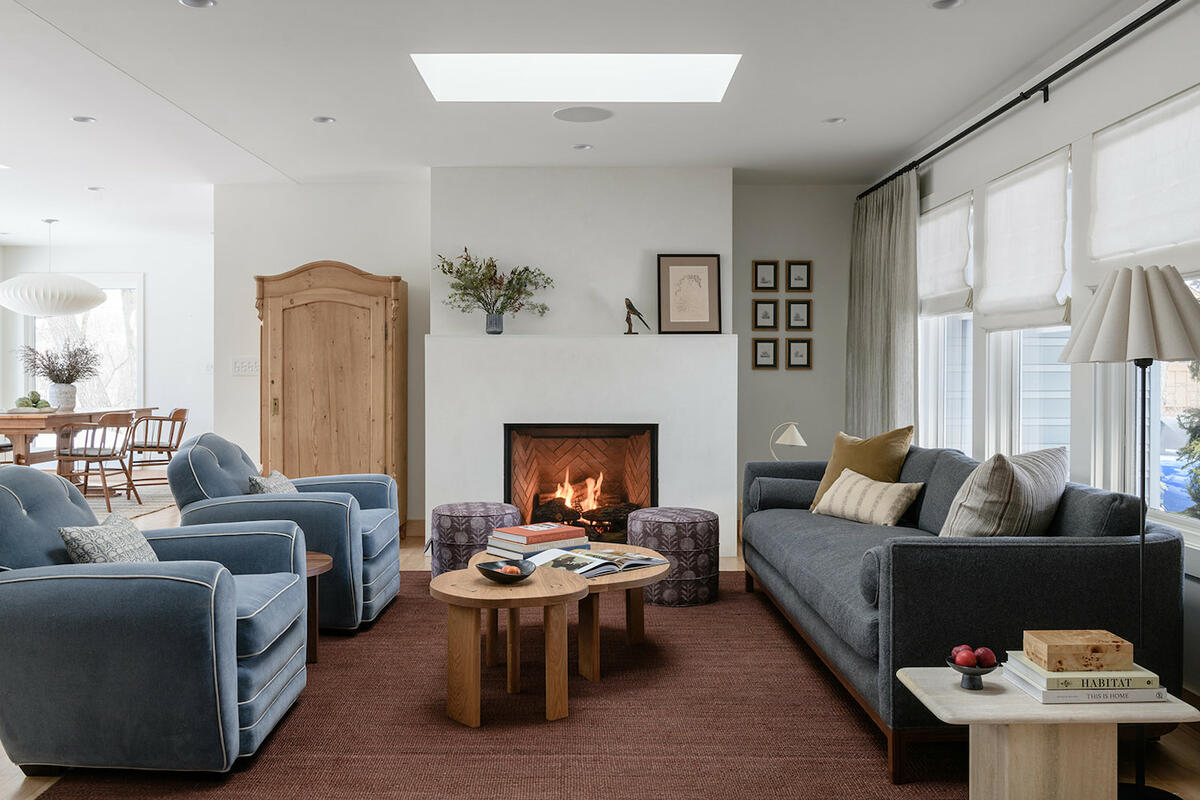
How have you approached billing for your work?
We charge hourly for all client work. We charge the same rate for everything we do, though I have been thinking about how to change it up a little bit. The business coach we worked with said to me, “You know, you’re a designer, and you’ve got to emphasize that design is the guts of your work.” I spend a lot of time on the process—on what he would say is delivering the “non-important” things. We’re very organized, so if clients want a shipping schedule, they can have it. If they want tracking information, sure. But that’s not actually what clients want. They want to feel seen. And so I’ve been working on how to change up our billing so that clients feel like it’s most beneficial for them.
What would that mean?
The recommendation that I’m still trying to figure out for us is a flat fee for the design. It’s about figuring out how to separate what is the heartbeat of your work—the design portion of the project—from the production portion. The idea is that while it’s critical, it’s not the reason clients hire us. Any designer can and should do that. The mental game is placing more emphasis—and a higher price point—on the design portion of the project, and then transitioning to either a monthly flat fee that we charge throughout the duration of the project or going down to a lower hourly rate until the installation is complete.
How would that change the way you talk about the work?
For the first couple of years of the business—I think as an emotional reaction to leaving my other job—feeling competent and trustworthy was super important to me. I don’t want people to have to worry or wonder, because they’re giving us a ton of money. But I think I’m overcompensating in some ways for my internal emotional dysregulation around feeling competent at this job, so much so that I was maybe emphasizing the process too much. And in wanting to emphasize that we’re competent and that we have things under control, I think I lost that magic communication with a client about what we’re doing and why we’re doing it in the first place—and that magic is transforming their lives.
I’m not a storyteller. I’ve been trained, and I think my natural inclination is to be like, “OK, A to B, this is how we’re going to do it.” So letting go of those reins a little bit to be able to tell the story of a project, or to tell the story of what clients will get from us that’s not a shipping schedule—that’s hard for me. But that’s what we’re selling, you know? We are in the business of selling not only good design but an experience—and obviously clients didn’t need to know that we will send a shipping schedule. They already expect that we’re going to deliver, so I was reinforcing what they were already thinking. What I need to do is focus on the parts that are harder to pin down. That’s been an evolution for me, trying to soul search about why I do this and how I can communicate to clients what we do that might be different from another firm.
That’s an amazing journey to go on.
It’s been an eye-opening experience of, like, “Oh, I’m actually not doing that part of my job as well as I could be”—and part of it is unearthing things that are preventing me from doing it, but also asking for help. I’m not a good copywriter, but I can explain why I did things for someone else to write about. So the contractor that we just hired part-time for design is also a writer, which was super interesting to me, because we end up writing a lot of copy—captions, blurbs and bios—and I do all of that now, but I’m not the best person at it. I’m way too factual and rigid. So I’d already been thinking, “Who can do this better than I can?” Coming from social work, where the team is everything, I’m very focused on how people can be their best—and I’ve learned that includes me too.

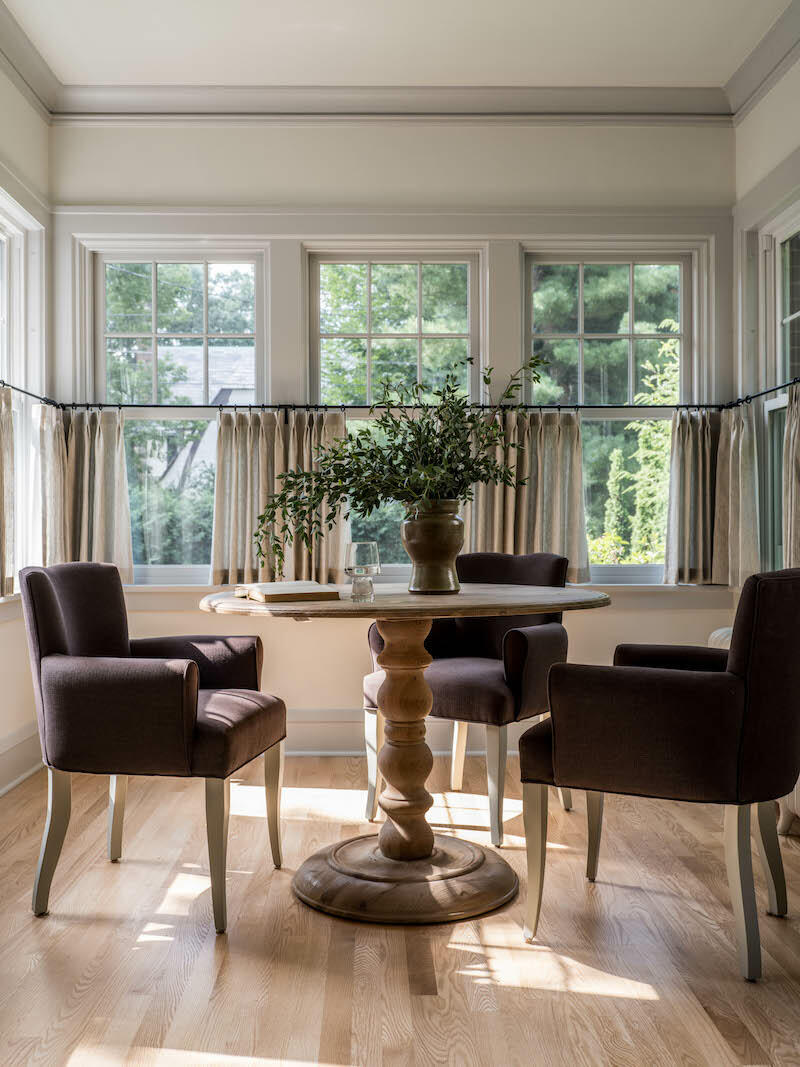
I’d love to hear more about your team. When did you start hiring?
After launching my firm in 2020, I had started to get quite a few projects. But I don’t use CAD and I can’t draw, so I was like, “Oh, shoot, I’ve got a big deliverable that I can’t do.” I had a virtual assistant who would help with floor plans, but I was like, “I need to make a 27-page paint schedule.” I realized I didn’t have the skills to do it, and I couldn’t turn it around in time because my virtual assistant was super slow. And just then, a person reached out on Instagram and said, “Hey, the designer I’m working for really slowed down during the first part of Covid. These are the things I can do, and I’m willing to work contract. Are you interested?” It was a totally cold reach-out. But she knew how to do CAD, how to use Ivy, and was used to doing the behind-the-scenes purchasing—all the things I’m terrible at. So she came on, and it was great. She eventually became a W-2 employee. Then she was like, “Hey, I’m too busy, and I would like to design more.” So we moved her into a design position and backfilled for the other work. She ended up leaving about a year and a half ago, but she was my first employee, and it was just the two of us for the first year.
My mental game about hiring is always getting the team together and asking, “What are the things we absolutely want to stop doing? Could we make it into a new job for someone else so we can keep doing what we love and hand off the things we don’t want to do anymore? And is it possible to combine all of those things into one job for someone else?” Sometimes it isn’t, but in this case it was. So we hired Samantha, who now has been with us for two and a half years. She started off in that project management, purchasing and expediter role—and after a while, she was like, “Hey, I’m also a designer, and we’re really busy.” So we did the same thing. Sarah then took Samantha’s job [and followed the same trajectory], and they are now our main designers. And because they have done all of that back-end stuff, they know how it all works. Then we hired Tina to backfill all the purchasing and project planning, and it was a perfect fit for her. She’s not a designer—she has no interest in design. She’s more of an operations person.
That’s interesting to find someone who likes the operations side in that role. Do you feel a difference?
We do. When we have an install for a whole week, I’d be like, “Oh, what are we going to do for lunch?” and everybody would be like, “We should order out, we’re all starving right now.” I remember thinking, “I should do this better.” Stuff like that was always happening, where I would feel like, “I’m not the best person for this.” Or keeping up our holiday calendar—I give my staff every other Friday off in the summer, but I wasn’t putting some of that stuff on the calendar. And Tina is just so on top of that kind of stuff. She’s like, “Here are the four places we can order lunch from on this install: This is the first day, second day, third day and fourth day. Give me your order for each place by this date, and I’ll have it delivered at 12:59 p.m. I’ll stock the fridge with LaCroix. Here are the things that the install bag is missing from last time. I noticed that your scissors broke, so I bought new ones.” Or she’ll be like, “Hey, Julia, we have a conflict on this day: We have a furniture pickup with Samantha and a drapery install with Sarah, and another client wants the delivery of these chairs to happen that day too. Can you be there or should I reschedule?” She also does all of our purchasing and project communication.
That sounds like heaven.
She was actually a social worker, too—and secretly, she’s my best friend. She had a really stressful job at a small health care company. She lived through the pandemic in that job and was getting burned out, so I said, “Come work for me.” Her skill set is perfect because we don’t need another designer—we have enough of those. She’s like, “Oh, turns out I actually don’t care about design. I care about all these other things that nobody else does—like, you know, profit margin.”
We went through the whole hiring process, my staff interviewed her—it wasn’t just like, “Hey, my best friend’s on the job now.” We’ve been friends for 20 years, but we’re both ex–social workers, so it’s not hard for us to have uncomfortable conversations, and we’re very much working at work. But it’s been great, because she’s taken on all of the things that I was letting go of because I was too busy but that absolutely needed to happen for the health of our company and for the health of my staff.
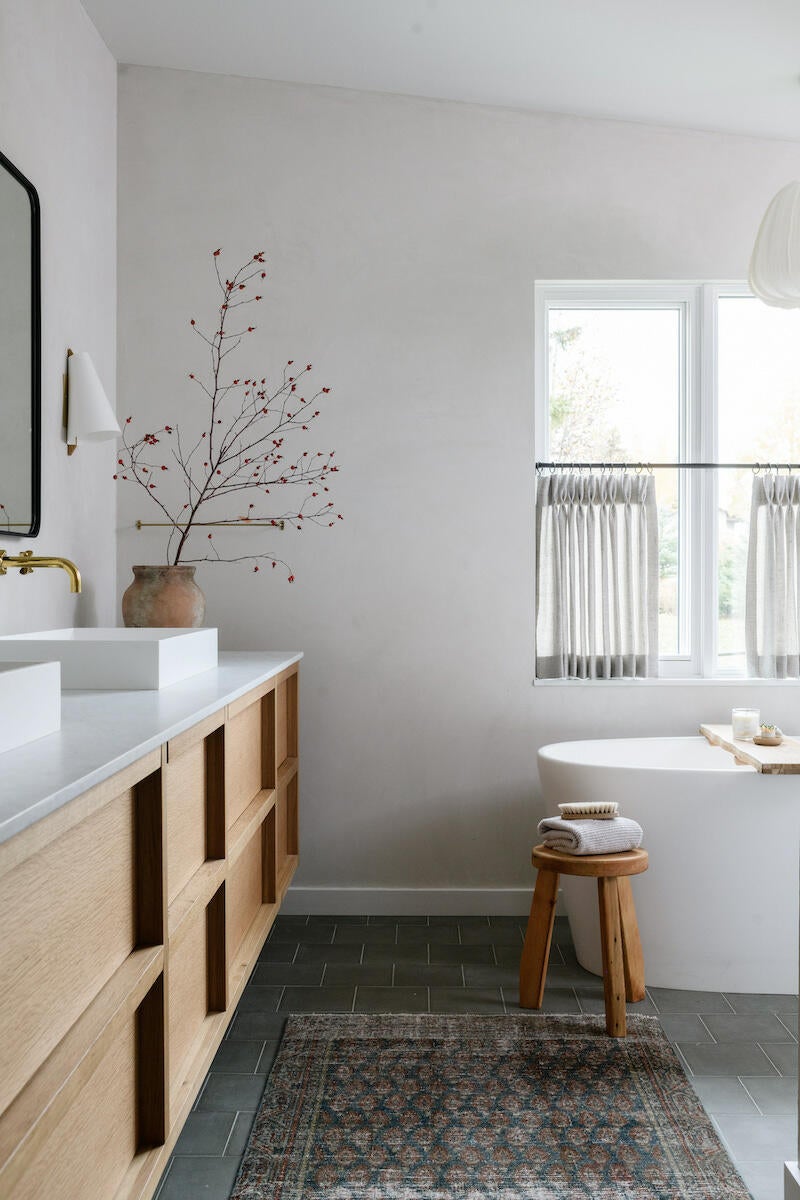
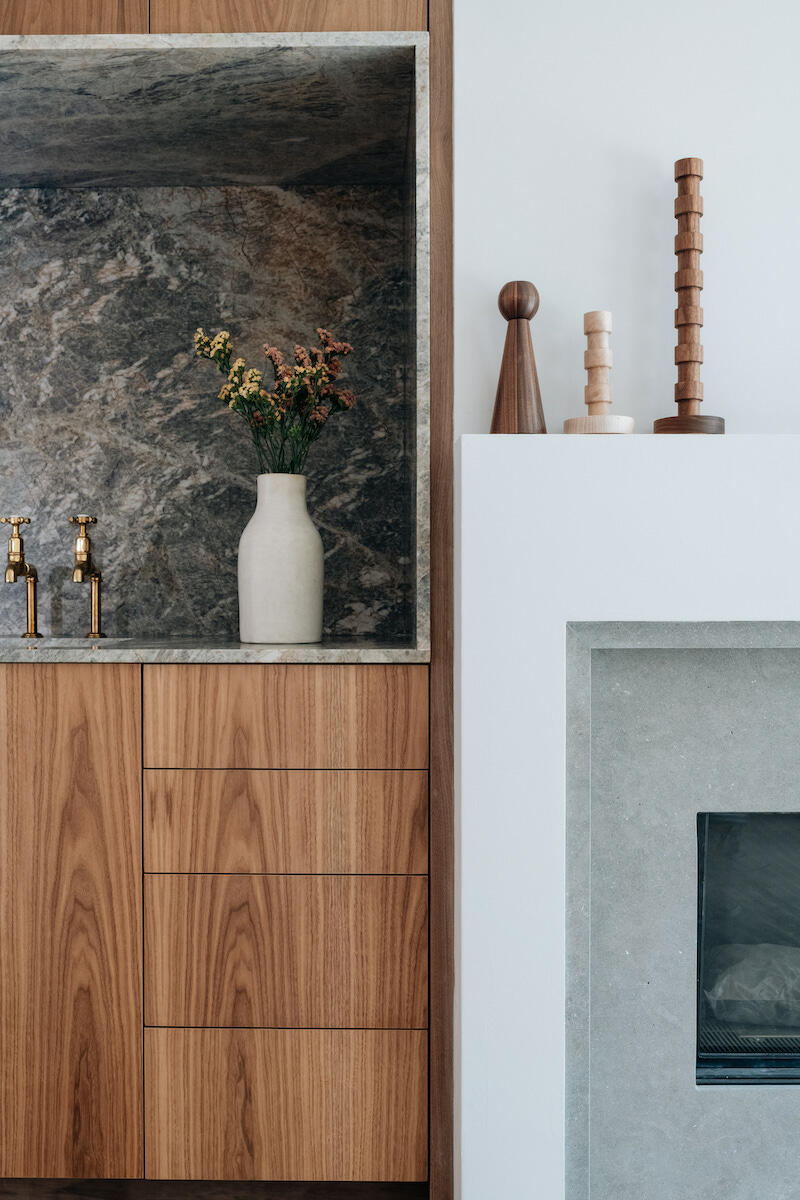
Can you tell me about the design scene in Minnesota?
I’m coming to it kind of late—I live here, but a lot of our work is out of state, so I’m a little bit behind in terms of knowing the good contractors or the best architects to work with. We’re just breaking into some of that now.
Is that a byproduct of launching during the pandemic, when so much work did go remote?
Totally. But I also think it’s our aesthetic. A lot of people here want a more traditional design. We’re also not a budget option: We’ve been told that the stuff we specify is more expensive, more difficult to install and costs more overall. We’re not going to do a 6,000-square-foot house and put in all chrome plumbing—that doesn’t interest us—so we’re kind of out on some of those big projects.
Aesthetically, we’re fairly flexible—we’ve done a little British kitchen, a really modern house, a wabi-sabi cottage—but at the same time, we don’t tend to use unnatural materials. If you want quartz everywhere, we might not be the best fit. People often come to us from mountain places: We’ve done a lot of work in Sun Valley and in Tahoe, and we’re working in the Hudson Valley. I don’t think that’s a comment on us or on a client; we’re just not the right fit for everybody. But it means I’m still learning, like, what is in Minnesota?
There are some amazing designers who we have good relationships with. I have referred projects to them that weren’t the right fit for us, and we all share information. But I don’t really get the sense that there’s a big community. I’m also not in ASID because I don’t have a degree, so maybe I’ve just missed out on some of the more formal stuff that happens in the industry. Sometimes I think there must be a strong design community where people come together, I’m just not privy to that because I don’t have the right qualifications.
What about sourcing? Do you shop locally, or is your network spread out across the country?
For most of our projects, we have stuff locally made in Minnesota. We have a great furniture maker here—just yesterday, we custom-designed some nightstands and a little entry table for a client in Sun Valley. We have those locally made because it’s way easier, and honestly it’s way more affordable. Same with cushions: We have a great workroom that does awesome custom pillows. A lot of our projects have bench seats, and we’ve found it’s easier to make all of it here. We have the measurements because we drew it, so we’ll make them and send them out. We also have a great specialty painter who does plaster and limewash finishes, so we’ve been toying with this idea of, “Would there ever be a world where she flies out to some of our projects?” Some of these markets don’t have those things—or it’s super saturated, so it’s hard to schedule people. We use a lot of local people on all of our projects.
For one of my projects in Sun Valley, we could not get a metalworker to make a bar—there just wasn’t anyone who wanted to take on that small project. So I contacted our guy here and I was like, “Hey, what do you think about making this for us?” He’s like, “Absolutely, and I’ll even deliver it.” So he drove out to Idaho, installed it and then went on vacation.
When you look back at the last couple of years, what is the biggest thing you know now that you wish you would have known when you started?
I wish I would have known that it’s going to be hard, but it’s going to be OK, and I can figure it out. I had a lot of anxiety—both about pivoting from a really stable career and also feeling so responsible for everything in the projects and for my staff. It was a big burden to bear, especially during the pandemic. Looking back on it, it’s like, “Oh, my gosh, that was a lot.” Only now can I appreciate how I don’t want to repeat some of that. So I would just say to myself, “Yeah, this is a hard job. Let’s not sugarcoat that things happen when you’re in construction and you work with a million people. It’s going to be hard; things are going to happen that are going to be expensive and that you have to pay for. And it’s OK—you’re going to figure it out. You’re going to do the right thing.”
What does success look like for you?
An office of happy people who want to come to work, who feel valued, who can be themselves. And on the client side, giving people that special feeling—whatever it is that makes them feel seen. I think that is the hallmark, for me, of our most successful projects.
To learn more about Julia Miller, visit her website or find her on Instagram.















